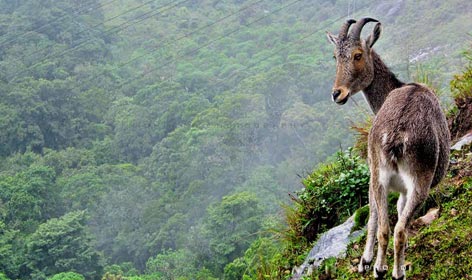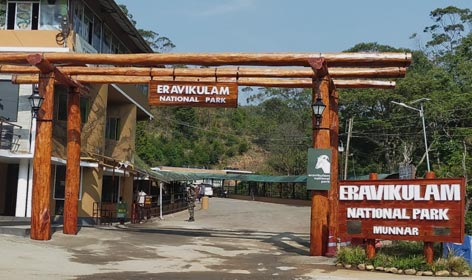Eravikulam National Park
Location - Devikulam Taluk of Idukki District on SH17, Kerala
Best time to visit - September to February
How to reach:-
Train - Aluva Railway Station (120 km)
Flight - Cochin International Airport (119 km)
Located at about 7000 ft above sea level, Eravikulam National Park is located at about 12.2 km from Munnar. The national park wears the badge of UNESCO World Heritage Site and is an exemplary region with a treasury of rich flora and fauna. Eravikulam National Park is famous for being the home to the endangered mountain goat, Nilgiri Tahr and the magnificent Neelakurunji flowers that bloom once in 12 years. When the flowers are in full bloom the whole park is blanketed in blue colour.


Eravikulam National Park is sprawled over about 97 sq km in the Kannan Devan Hills of the Southwestern Ghats. The breathtaking sights of tea gardens and rolling mountains make the national park one of the most preferred tourist destinations. The undulating topography of the Eravikulam National Park is adorned with grasses, sholas and hillocks. The national park is divided into three parts - core, buffer and tourism zones. Trekking and other eco-tourism activities are conducted in the tourism zone of the park and tourist entries are restricted in the tourism zone only which lies in the Rajamalai area.
Places of interest at Eravikualam National Park include Anamudi Peak (the highest peak in South India), Attukkad Waterfalls, Lakkom Waterfalls, Echo Point and Forest Rose Garden. Nearby tourist places or attractions are located at Munnar, Idukki, Vagamon, Chinnar Wildlife Sanctuary and Thattekad Bird Sanctuary.
History - Till 1971, Eravikulam National Park was a game reserve managed by the Kannan Devan Hill Produce Company. An independent non-governmental organisation, High Range Game Preservation Association, was in charge of the management and protection of the region back then. Several naturalists and scientists were attracted towards the park for its potential of being fertile land for plantations. Colonel Douglas Hamilton and J.D. Munro are the early European explorers and in 1877 they acquired around 581.12 sq km of land at a petty price of Poonjat Raja and in 1879, North Travancore Plantation and Agricultural Society was established. The land was distributed among the plantation members who cultivated coffee and cinchona. However, later the land was found to be more suitable for the cultivation of tea and eucalyptus. In 1980, the first tea plantation in the High Ranges was begun cultivating, where normal vegetation was cultivated previously. Soon the region became a chief centre of commercial cultivation and it was also the place of interest for the English hunters for their favourite hunting game of Nilgiri Tahr, Barking Deer, Sambar Deer, Gaur, Wild Boar, and Tiger. In 1971, the Kannan Devan Hills (Resumption of Lands) Act was implemented, where the lands excluded from the ownership of the company went back to the Kerala Government, which was intended to allocate for agriculture purposes. But with the intervention of planters, bureaucrats, naturalists, and scientists, the government declared the region as Eravikulam-Rajamalai Wildlife Sanctuary in 1975 and the status upgraded to the national park in 1978.
Safari - Entry of vehicles is prohibited inside the wildlife sanctuary, except for the motorable areas on the southern edge of the safari zone of Rajamalai, in the direction of the Rajamallay tea estate and in the areas of Lakkom Muruvakudy. In the non-motorable areas, tourists need to explore the national park on their feet to witness glimpses of the majestic wilderness of Eravikulam National Park. The walking trail involves frequent sightings of Nilgiri Tahrs and near the check post, there is an interpretation centre for the convenience of the visitors to collect information about the Eravikulam National Park.
Flora - Neelakurunji flowers, Brachycorythis Wightii Orchid, Habenarea Flabelliformis, Drosera Peltata, Piper Schmidt, Elateria Cardamomum, Mahonia Leschnaultti, Rhododendron Arboreum, Gaultheria Fragrantissima, Berberis Tinctoria, Grasslands, Shrub land and Forest covers.
Fauna - Nilgiri Tahr, Nilgiri Marten, Jungle Bush Quail, Indian Golden Backed Three-Toed Woodpecker, Small Green Barbet, White Breasted Kingfisher, several endangered species of butterflies, Keeled Grass Skink, Palni Shield Tail Snake, Gunther’s Vine Snake, Ridged Toad, Leith’s Leaping Frog, Yellow-Bellied Bush Frog, Lipped Algae Eater, Cardamon Garra, common Rainbow Trout, etc.
Kerala Tour Packages:
- Amazing Kerala Budget Tour
- Best Magical Kerala Tour
- Exotic Kerala Tour
- Offbeat Kerala Family Package
- Kerala Hills Backwater Beaches
- Through the Hills and Backwaters
- Beaches and Backwaters of Kerala
- Enchanting Hill Stations Tour
- Relaxing Beach Vacation
- Beach Excursion of Kerala
- Kerala Tamilnadu Tour
- Tamilnadu tour with kerala
- Kerala and tamilnadu package
- Karnataka and Tamil Nadu